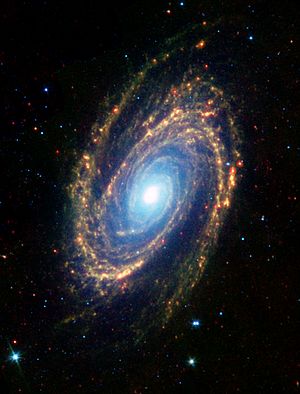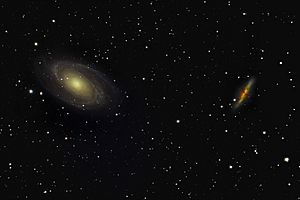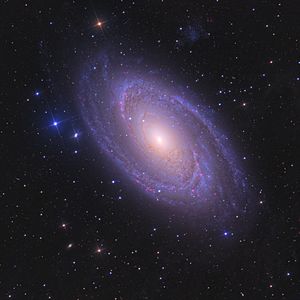Messier 81 facts for kids
Quick facts for kids Messier 81 |
|
|---|---|

The HST's view of M81, with its open star clusters, globular star clusters, and regions of fluorescent gas.
|
|
| Observation data (J2000 epoch) | |
| Constellation | Ursa Major |
| Right ascension | 09h 55m 33.2s |
| Declination | +69° 3′ 55″ |
| Redshift | −0.000113 |
| Helio radial velocity | −34 |
| Galactocentric velocity | 73 |
| Type | SA(s)ab, LINER |
| Apparent dimensions (V) | 26.9 × 14.1 moa |
| Apparent magnitude (V) | 6.94 |
| Other designations | |
| NGC 3031, UGC 5318, MCG+12-10-010, PGC 28630, Bode's Galaxy | |
| See also: Galaxy, List of galaxies | |
Messier 81 (also known as NGC 3031 or Bode's Galaxy) is a huge spiral galaxy. It is found in the constellation called Ursa Major, which is also known as the Great Bear. This galaxy is very far away, about 12 million light-years from our Earth.
Messier 81 has a very bright center, which means it has an active galactic nucleus. This bright center is powered by a supermassive black hole. Because it is so big and bright, many astronomers, both professional and amateur, enjoy studying and observing it.
This galaxy is quite dusty. You can find a lot of interstellar dust in its spiral arms. This dust is often found near areas where new stars are forming. Hot, young blue stars in these areas heat up the dust, causing it to glow with infrared energy.
Contents
Discovery of Messier 81
Messier 81 was first spotted by a German astronomer named Johann Elert Bode. He discovered it on December 31, 1774. This is why it is sometimes called "Bode's Galaxy."
Later, in 1779, Pierre Méchain and Charles Messier also found this galaxy. Charles Messier then added it to his famous list of celestial objects, the Messier catalogue.
How to See Messier 81
You can find Messier 81 about 10 degrees northwest of a bright star called Alpha Ursae Majoris (Dubhe). It is part of a group of galaxies known as the Messier 81 Group.
Messier 81 and its neighbor, Messier 82, are great objects to look at with binoculars or a small telescope. You usually can't see them with just your eyes, unless the sky is extremely dark and clear. To see more details in the galaxy, like its spiral arms, you'll need a telescope with a lens at least 8 inches (20 cm) wide.

Interstellar Dust in the Galaxy
Most of the light we see from Messier 81 in infrared wavelengths comes from interstellar dust. This dust is mainly located in the galaxy's spiral arms. It is closely linked to areas where new stars are being born.
The hot, short-lived blue stars in these star-forming regions are very good at heating up the dust. This heating makes the dust glow brightly in infrared light.
Star Clusters and Radio Bursts
Scientists believe that Messier 81 has about 210 globular clusters. These are large, tightly packed groups of millions of stars.
In early 2022, astronomers found something interesting. They reported that Messier 81 might be the source of a repeating fast radio burst called FRB 20200120E. Fast radio bursts are very powerful, quick flashes of radio waves from space.
Supernova SN 1993J
Only one supernova has been seen in Messier 81. A supernova is a huge explosion that happens when a star dies. This supernova, named SN 1993J, was discovered on March 28, 1993, by F. García in Spain.

At its brightest, SN 1993J was the second brightest supernova seen in the 20th century. It looked like a Type II supernova, which comes from a giant star exploding. But over time, it changed, showing features of another type of supernova. This helped scientists learn more about how different types of stars explode.
Scientists used this supernova to estimate how far away Messier 81 is. They calculated it to be about 8.5 million light-years from Earth.
Messier 81's Neighbors
Messier 81 is the biggest galaxy in the M81 Group. This group has 34 galaxies and is also in the Ursa Major constellation. At about 11.7 million light-years away, the M81 Group is a close neighbor to our own Local Group of galaxies, which includes the Milky Way.
Messier 81's strong gravity has pulled on its neighbors, Messier 82 and NGC 3077. This pulling has created long, thin streams of hydrogen gas connecting the galaxies. These interactions have also caused gas to rush into the centers of M82 and NGC 3077. This led to a lot of new stars being born in those galaxies, a process called starburst activity.
Related pages
See also
 In Spanish: Galaxia de Bode para niños
In Spanish: Galaxia de Bode para niños


